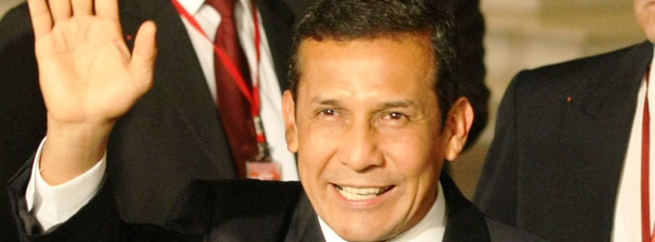
Ollanta Humala’s Path to Peruvian President
05 August, 2011In 2000, Ollanta Humala led an unsuccessful military rebellion against Peru’s then-President Alberto Fujimori. Six years later, the left-wing nationalist entered the political realm, losing to Alan Garcia in the presidential runoff.
During the 2006 campaign, Humala eagerly compared himself to to Hugo Chavez and Evo Morales, the left-wing socialist leaders from Venezuela and Bolivia, respectively. Humala signalled his willingness to help Peru enter the “family” of governments led by Chavez, Morales and, to a lesser extent, Rafael Correa, the president of Ecuador.
While sharing the stage with Chavez and Morales in Caracas, Humala received the endorsement of the Venezuelan leader. Humala also expressed admiration for General Juan Velasco Alvarado, who ruled Peru from 1968 to 1975. The failed economic policies of Velasco were still fresh in the minds of many voters.
Despite his loss to Garcia, few observers doubted the former lieutentant colonel would seek the presidency again. He did, entering the race to replace Garcia, who was banned from running for a second consecutive term. However, just months before the first round election, Humala found himself in fourth place in most polls, trailing former President Alejandro Toledo; Keiko Fujimori, the daughter of former President Fujimori; and Luis Castaneda, the former Mayor of Lima. As Election Day neared, Toledo and Castaneda began to fade, while an additional candidate, former economic minister Pedro Pablo Kuczynski, picked up support among Lima’s elite, many of whom were terrified by the prospect of Humala winning.
Humala emerged as the clear leader in the first round election results. The contest to see who would face him in the June runoff was close, but Fujimori was eventually certified as the second place finisher, fending off the Oxford and Princeton-trained economist Kuczynski by a small margin.
The international reaction to the Humala-Fujimori runoff was as negative and brutal as it was uniform.
Dennis Jett, a former U.S. Ambassador to Peru, wrote that the “outcome could not have been worse,” describing it as “Peru’s political suicide.” The Economist headline declared “Peru’s presidential election: The masses blow a raspberry.”
Mario Vargas Llosa, Peru’s most famous novelist, likened the choice to deciding between “AIDS and cancer.” While he did not reveal which candidate represented which disease, Vargas Llosa ultimately supported Humala. Vargas Llosa said he made the decision “unhappily and with fear” because he felt Fujimori represented a greater threat to democracy.
Although Humala had never held public office, had participated in a failed coup and had close ties to Chavez, in comparison to Fujimori, whose ex-president father was serving a 25-year prison sentence for human rights violations, he began to be seen as a more acceptable option to many. Ambassador Jett did not hold back when describing Fujimori’s qualifications to be president. “It would be like Tricia Nixon running for president at age 35, if her father had received the jail time he deserved, with a program that consisted of nothing more than pardoning him,” he wrote. Despite Humala’s rather sketchy human rights record – Humala has been accused of torture and murder against Shining Path members in the 1990s – with a Fujimori on the ballot, Humala became the de facto human rights candidate.
Humala and his advisors made a hard shift towards the center, trading Venezuela’s Chavez for Brazil’s center-left Lula as a governing role model. After a horrible showing within the capital of Lima and among voters outside of the nation’s highlands regions and working class in the first round voting, Humala’s political shift was designed to show middle and upper class voters that he could be trusted to sustain Peru’s rapid economic growth.
Humala’s pronounced political shift could be interpreted a number of ways. Ultimately, it reflected a man willing to change along with his country. The fact that three centrist candidates, all preferred by the Lima elites, had been cast away in favor of Humala and Fujimori said a lot about the state of Peru.
While the economy had expanded greatly, particularly its mining sector which was fuelled by foreign investment, that newly created wealth was not being felt in all parts of the nation. Peru’s highlands, home to a large population of poor indigenous people, did not feel like they were benefiting from Peru’s newfound wealth. Some accused Humala of inciting class warfare to win votes, but the results spoke for themselves.
Humala did win the runoff, edging Fujimori, and took office in July. While he has indeed reached out to Fidel Castro, Chavez and Morales in recent months, Humala does not appear to be as his harshest critics had advertised.
Humala chose to rely on orthodox economists and former members of the Garcia administration to make up much of his economic team. Humala’s pick for prime minister, finance minister and energy minister are all pro-market with experience in past presidential administrations. Their selections caused Peruvian stocks to rally, after suffering a pronounced drop since Humala won the election.
So far at least, Humala as president bears little resemblance to the 2006 presidential candidate and even less to the 2000 rebellious military leader. Whether that’s a good thing depends on who you ask. Peru’s elite class can only feel cautiously optimistic given Humala’s cabinet appointments and his economic policy team. The voters who served as Humala’s electoral base – Peru’s working class, particularly those outside of Lima – may be disappointed at Humala’s change of tune.
The future of Peru under Humala remains in doubt, but at the very least the Andean nation seems to have avoided the “political suicide” forecasted by Ambassador Jett.
And any observer of Peruvian politics I would not let this article end without adding two words to follow the previous sentence: “for now”.
Follow Sounds and Colours: Facebook / Twitter / Instagram / Mixcloud / Soundcloud / Bandcamp
Subscribe to the Sounds and Colours Newsletter for regular updates, news and competitions bringing the best of Latin American culture direct to your Inbox.

